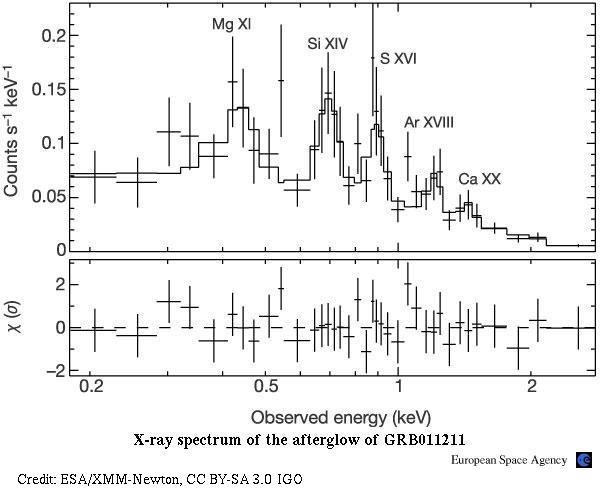X-ray spectrum of the afterglow of GRB011211

Minimum credit line: Image courtesy of ESA. (for details, see Conditions of Use).
Credit: ESA/XMM-Newton, CC BY-SA 3.0 IGO
The image above can be displayed at full size and may be downloaded by clicking the image above.
| About this Image |
|---|
The gamma-ray burst GRB011211 was first detected on 11 December 2001 at 19:09:21 UT, by the Beppo-SAX satellite; the burst duration was 270 s (making GRB011211 the longest burst observed by Beppo-SAX), with a peak flux (40-700 keV) of 5 10-8 erg cm-2 s-1. Spectroscopy of the optical afterglow revealed several absorption lines at a redshift of z = 2.141+-0.001, and R-band imaging has linked the optical transient with extended emission - the probable host galaxy - of magnitude mv = 25.0+-0.5. Assuming the absorption system arises from the GRB host galaxy, and adopting a cosmology of H0 = 75 km s-1 Mpc-1 and q0 = 0.1, implies a total equivalent isotropic energy for GRB011211 of 5 1052 erg. The observations of GRB011211 by the orbiting XMM-Newton X-ray telescope started at 06:16:56 UT on 12 December 2001, 11 hours after the initial burst. Data from the European Photon Imaging Cameras (EPIC) have been analysed, using both the MOS and pn instruments; the total observation duration is 27 ks. The time-averaged 0.2–10 keV flux, F, was 1.9 10-13 erg cm-2 s-1, decreasing with time t during the observation as F(t) proportional to t-(1.7+-0.2). The Optical Monitor detected the burst afterglow in both the visible and ultraviolet (UVW1) bands, with magnitudes of 21.12+-0.13 and 21.6+-0.3, respectively. The image shows the XMM-Newton EPIC-pn spectrum of the GRB011211 afterglow, for the first 5 ks of exposure only. The observations strongly favour models where a supernova explosion from a massive stellar progenitor precedes the burst event and is responsible for the outflowing matter.
Investigator(s): J. N. Reeves
| For More Information |
|---|
- Read the Press Release
- Read the Journal article
- Visit related website;
http://xmm.esac.esa.int/external/xmm_news/items/grb011211/index.shtml - Detailed description of this image
- Query XSA archive for XMM-Newton data in the field of GRB011211
- Astronomical database entries for GRB011211;
- Query NED for more images about GRB011211
- Query SIMBAD for more GRB011211 data
- For unfamiliar terms, visit the XMM-Newton Astronomical Glossary
| Instrument | EPIC pn | ||
| Observing Mode | Full Frame | ||
| Filter | Thin | ||
| Date of Observation | 2001-12-12 | ||
| Image size | 30.00 x 30.00 arcmin | ||
| Detailed Caption | Top panel, the observed count rate spectrum; bottom, the residuals of the thermal model compared with the data points, in units of 1 deviations. The energy plotted on the abscissa is in the observer frame. Emission lines are detected at energies (keV) of 0.45+-0.03, 0.70+-0.02, 0.89+-0.01, 1.21+-0.02 and 1.44+-0.04 in the observed spectrum, whilst the measured line fluxes (erg cm-2 s-1) are (7.6+-5.1)10-15, (1.1+-0.3)10-14, (9.9+-2.9)10-15, (6.7+-2.5)10-15 and (4.4+-2.2)10-15, respectively. These correspond to energies (keV) of 1.40+-0.05, 2.19+-0.04, 2.81+-0.04, 3.79+-0.07 and 4.51+-0.12 in the burst rest frame (at z = 2.14), with rest-frame equivalent widths (eV) of 180+-120, 430+-130, 480+-140, 460+-170 and 360+-180, respectively (all errors are quoted at 1 confidence). Note that an iron K line is not detected; the upper limit on the rest-frame equivalent width is < 400 eV. For reference, the resolution (full-width at half-maximum) of the EPIC-pn spectrum is 100 eV at 1 keV. The emission lines can be identified with the K transitions of Mg XI (or Mg XII), Si XIV, S XVI, Ar XVIII, and Ca XX. The observed energies are blue-shifted by a factor corresponding to a velocity of v = 0.086c (or 25,800 km s-1), when compared to the redshift of the gamma-ray burst (at z = 2.14). For clarity, only the EPIC-pn data are shown; consistent results are obtained for the EPIC-MOS camera, although the signal-to noise ratio of the MOS data is lower. | ||
| Alternate Resolutions | (Help) |
|---|
This image is available in the following downloadable versions: Higher resolution versions of this image may be available, please contact the XMM-Newton HelpDesk.
Search the Image Gallery
To search the Image Gallery for a particular object, fill in the object name in the box below and click the Submit button.To search the Image Gallery for other images, fill in any of the fields below and click the Submit button.
For more search options, please use our Advanced Search form.